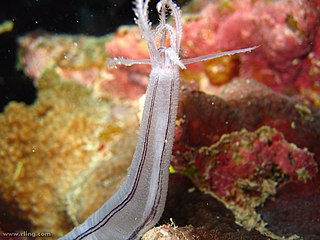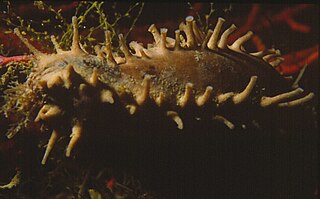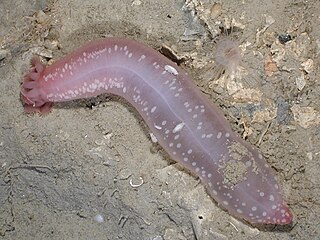
Sea cucumbers are echinoderms from the class Holothuroidea. They are marine animals with a leathery skin and an elongated body containing a single, branched gonad. They are found on the sea floor worldwide. The number of known holothurian species worldwide is about 1,786, with the greatest number being in the Asia-Pacific region. Many of these are gathered for human consumption and some species are cultivated in aquaculture systems. The harvested product is variously referred to as trepang, namako, bêche-de-mer, or balate. Sea cucumbers serve a useful role in the marine ecosystem as they help recycle nutrients, breaking down detritus and other organic matter, after which bacteria can continue the decomposition process.

Apodida is an order of littoral to deep-sea, largely infaunal holothurians, sea cucumbers. This order comprises three families, 32 genera and about 270 known species, called apodids, "without feet".

The California sea cucumber, also known as the giant California sea cucumber, is a sea cucumber that can be found from the Gulf of Alaska to Baja California. It is found from the low intertidal zone to a depth of 250 m (820 ft). They are most abundant in areas with moderate current with cobbles, boulders or bedrock. They are artisanally fished.

Dendrochirotida are an order of sea cucumbers. Members of this order have branched tentacles and are suspension feeders. Examples include Thyonella and Cucumaria.

Cucumaria miniata is a species of sea cucumber. It is commonly known as the orange sea cucumber or red sea cucumber due to its striking color. This northeast Pacific species is often found wedged in between rocks or crevices at the coast or on docks and can generally be identified by its orange bushy tentacles protruding above the substrate.

Holothuria atra, commonly known as the black sea cucumber or lollyfish, is a species of marine invertebrate in the family Holothuriidae. It was placed in the subgenus Halodeima by Pearson in 1914, making its full scientific name Holothuria (Halodeima) atra. It is the type species of the subgenus.
Molpadida is an order of sea cucumbers. The body shape is fusiform and unlike other sea cucumbers, their hind body is narrowed to form a distinct tail. Although they possess tentacles around the mouth derived from the water vascular system, they have no true tube feet, and are therefore believed to be related to the Apodida.

Synaptula lamperti is a species of sea cucumber in the family Synaptidae in the phylum Echinodermata, found on coral reefs in the Indo-Pacific region. The echinoderms are marine invertebrates and include the sea urchins, starfish and sea cucumbers. They are radially symmetric and have a water vascular system that operates by hydrostatic pressure, enabling them to move around by use of many suckers known as tube feet. Sea cucumbers are usually leathery, gherkin-shaped animals with a cluster of short tentacles at one end. They live on the sea bottom.

Psolidae is a family of sea cucumbers, marine animals with elongated bodies, leathery skins and tentacles that are found on the sea bed.

Caudinidae is a family of sea cucumbers, marine animals with elongated bodies, leathery skins and tentacles that are found on the sea floor.

Holothuria forskali, the black sea cucumber or cotton-spinner, is a species of sea cucumber in the family Holothuriidae. It is found at shallow depths in the eastern Atlantic Ocean and the Mediterranean Sea. It was placed in the subgenus Panningothuria by Rowe in 1969 and is the typetaxon of the subgenus.

Bohadschia argus, the leopard sea cucumber, leopardfish, or tigerfish, is a species of marine invertebrate in the family Holothuriidae.

Sclerodactyla briareus, commonly known as the hairy sea cucumber, is a species of marine invertebrate in the family Sclerodactylidae. It is found in shallow waters in the western Atlantic Ocean.

Holothuria edulis, commonly known as the edible sea cucumber or the pink and black sea cucumber, is a species of echinoderm in the family Holothuriidae. It was placed in the subgenus Halodeima by Pearson in 1914, making its full scientific name Holothuria (Halodeima) edulis. It is found in shallow water in the tropical Indo-Pacific Ocean.

Ocnus planci is a species of sea cucumber in the family Cucumariidae. It is native to the north-eastern Atlantic Ocean.

Chiridotidae is a family of sea cucumbers found in the order Apodida. Within the family, there are 16 recognized genera all with different ranges of body types and functions. Sea cucumbers play a fundamental role in many marine ecosystems.
Psolus chitonoides, also known as the slipper sea cucumber, armoured sea cucumber, creeping armoured sea cucumber, or creeping pedal sea cucumber, is a species of sea cucumber in the family Psolidae. It is found in shallow water on the western coast of North America. The scientific name "chitonoides" means resembling a chiton.

Eupentacta quinquesemita is a species of sea cucumber, a marine invertebrate with an elongated body, a leathery skin and tentacles surrounding the mouth. It is commonly known as the stiff-footed sea cucumber or white sea cucumber, and occurs on rocky coasts in the northeastern Pacific Ocean.

Paraleptopentacta elongata is a species of sea cucumber in the family Cucumariidae. It is found in the northeastern Atlantic Ocean and parts of the Mediterranean Sea. It is an infaunal species, occupying a burrow in the seabed, from which its anterior and posterior ends project.

Taeniogyrus dunedinensis, commonly known as the burrowing sea cucumber, is a small sea cucumber from New Zealand.


















